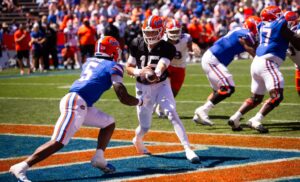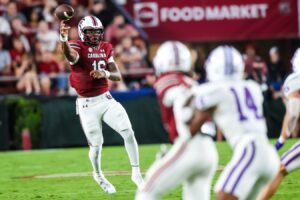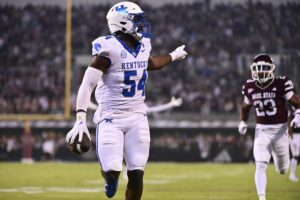Bo Pelini has returned to LSU as defensive coordinator after resigning as Youngstown State’s head coach in January. He had previously served in that role in Baton Rouge for three seasons, 2005-2007. He is replacing Dave Aranda as defensive coordinator. Aranda left at the end of the 2019 season to take over as head coach at Baylor.
The return of Bo Pelini to LSU will be a big story line in any 2020 season. What does it mean for LSU, specifically for the Tigers’ defense? Some insight can be gleaned from how his crews fared during his previous tenure.
The Return Of Bo Pelini To LSU
Results Under Pelini
LSU’s defense struggled in the first two games of the 2005 season. The disruption of fall camp and the team’s lives due to Hurricane Katrina may have played a role. In the season opener at Arizona State, the defense allowed 31 points and 461 passing yards. Those were the highest totals of the season. The following week, at home versus Tennessee, Pelini’s group surrendered 24 points in regulation and the game-deciding touchdown in one overtime period. The Volunteers’ 250 yards through the air amounted to the second highest amount allowed in regulation time.
Despite the rough start, Pelini’s group improved over the remainder of the season. They only allowed one of the 11 remaining opponents to score more than 17 points. Of those opponents, only two exceeded 200 passing yards. Just one had more than 200 rushing yards. They kept four opponents out of the endzone. They held six opponents to single-digits on the scoreboard. At year’s end, they had surrendered an average of 13.2 points, 173.8 passing yards and 89.9 rushing yards per game. They finished ranked sixth in the FBS in average rushing yards and eleventh in passing yards allowed per game.
In 2006, LSU’s defense improved for the most part. The squad allowed just 11.4 points and 145.7 passing yards on average per game. Only three opponents scored 20 or more points. No one scored more than 30. Of their 12 opponents, merely two exceeded 200 yards through the air. Four opponents had gained more than 100 rushing yards as had occurred in 2005. This squad permitted the third fewest average passing yards per game out of 119 FBS teams.
Despite winning the national championship in 2007, LSU’s defense regressed statistically. Opponents averaged 178 passing yards and 16.1 points per game, excluding overtime periods. Six of 14 opponents scored more than 20 points and piled up more than 200 passing yards in regulation time. Five teams gained at least 100 yards on the ground, including one with 201 yards and another with 385 during four quarters. Of the 120 FBS programs, they ended the season ninth in terms of average passing yards, twelfth in rushing yards allowed per game and tied for fifth for forcing 2.6 turnovers on average per game.
Results Without Pelini
How much difference did Pelini’s coaching make? One way to answer that is to compare how LSU’s defense fared during the season prior to his arrival and immediately following his departure.
In 2004, the final season of Nick Saban’s tenure in Baton Rouge, LSU’s defense allowed exactly 16 points in regulation on average in 12 games. The group permitted more than 200 passing yards in just three games and never more than 300 in a game. They limited three opponents to fewer than 100 passing yards for an average of 155.1 per contest. On the ground, only one team gained more than 200 yards. Eight of them accumulated fewer than 100 yards. Opponents averaged 99.8 rushing yards per game. At season’s end, they were ranked fifth nationally on average in terms of passing yardage surrendered and seventh in rushing yards.
In the season following Pelini’s departure, the defense declined. Opponents compiled 19.9 points in regulation on average. Just counting statistics from the four quarters of regulation time of every game, nine teams passed for more than 200 yards with two of them exceeding 300. The Tigers allowed 213.6 passing yards on average. They also surrendered an average of 110 rushing yards per game despite holding half of their opponents to fewer than 100 yards. They finished with the 47th highest average of passing yards allowed per game out of 120 FBS teams.
Great Coaching Or Great Players?
How much were those statistics due to the quality of players during Pelini’s time roaming the sidelines of Tiger Stadium? From the first batch of defenders coached by Pelini, three linemen were drafted in 2006 but no others. Future four-time Pro Bowler Kyle Williams was among those. In the 2007 draft, the Redskins selected LaRon Landry, picked for the Pro Bowl in 2012, in the first round. However, the only other defender chosen was in the seventh round. In the draft following the national championship season, three Tiger defenders were picked, all in the first four rounds. Those included Glenn Dorsey in the first, Chevis Jackson in the third and Craig Steltz in the fourth.
In the draft before Pelini’s tenure, only three defensive players were drafted. However, those included Marcus Spears in the first round, Corey Webster in the second and Travis Daniels in the fourth. Following the 2008 season, the Forty-Niners selected defensive end Tyson Jackson in the first round. No other defenders were picked until safety Curtis Taylor and defensive tackle Ricky Jean-François were tabbed in the final round.
Conclusion
After Pelini headed to Nebraska to lead that program, Les Miles replaced him with co-defensive coordinators, Doug Mallory and Bradley Dale Peveto. Both had arrived at LSU as members of Miles’ first staff there. Mallory had coached defensive backs while Peveto had been in charge of special teams and linebackers.
Miles’ decision appeared erroneous after one season. The defense worsened. Both coordinators apparently left voluntarily. However, both landed at lower status programs. Mallory became as defensive coordinator at New Mexico. Peveto took over as head coach at FCS Northwestern State.
In 2019, LSU’s defense played adequately. However, it did not serve as the driving force toward the undefeated national championship. The squad finished 59th in the FBS for passing yards allowed per game (222.7) and 21st in rushing yards permitted (121.5). The question is whether Pelini can return LSU’s defense to the lofty status that it held during his previous tenure in Tiger Stadium.






